How to Decorate a Large Living Room
By: Amanda Griffin
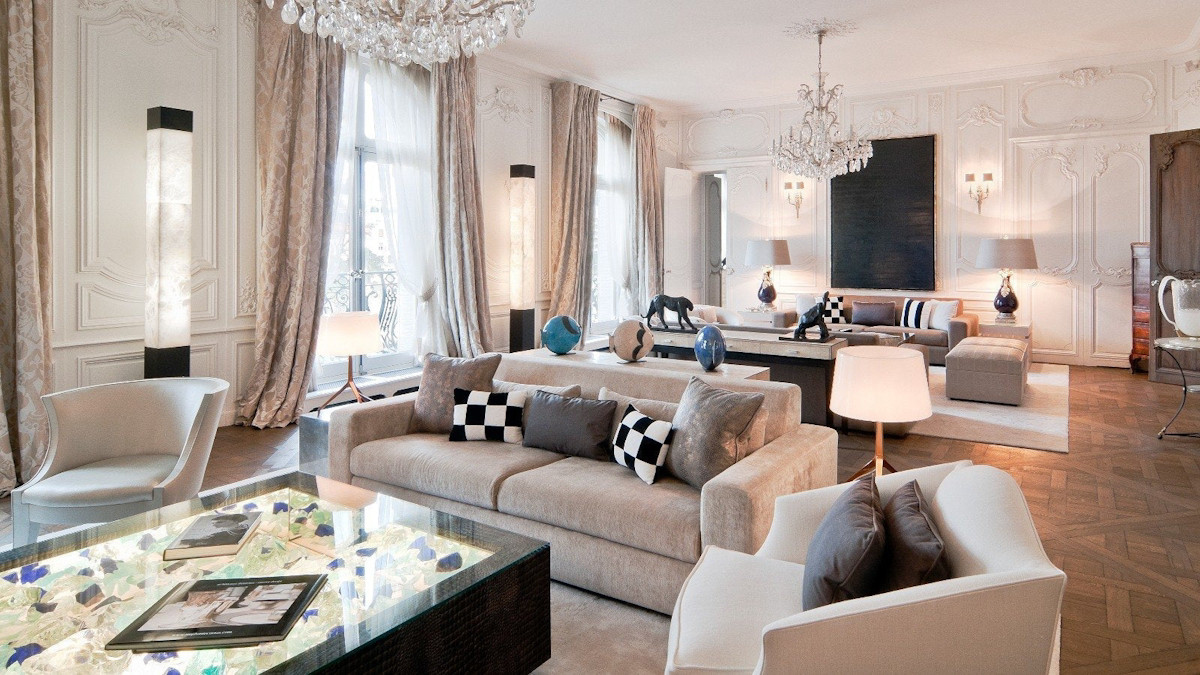
Decorating a large living room can be an exciting but complex challenge. With so much space to work with, the possibilities may seem endless, but finding the right balance between style and functionality is key. A large room has the potential to feel open and inviting, but without careful planning, it can easily feel cold or disconnected.
Whether you’re dealing with a completely empty space or a room that needs a fresh perspective, the goal is to create a design that feels cohesive, comfortable, and reflective of your personal style. From defining functional zones to choosing the perfect combination of colors and furniture, there are countless ways to transform a large living room into the centerpiece of your home.
In this guide, we’ll share practical ideas and creative tips to help you embrace the opportunities that come with decorating a spacious living room. By the end, you’ll feel equipped to make the most of your space, turning it into a harmonious and welcoming retreat for your family and guests.
Creative Ways to Arrange Your Large Living Room
Decorating a large living room doesn’t have to feel overwhelming. Instead of seeing one expansive space, consider breaking it into thoughtfully designed areas, each with its own function and personality. By dividing the room, you’ll not only make it more manageable but also more inviting and versatile. Let’s explore some practical strategies to help you transform your large living room into a cohesive, functional masterpiece.
Living room zones
One of the best ways to make a large living room feel cohesive and purposeful is to divide it into distinct zones. This approach isn’t about physically partitioning the room, but rather giving different areas unique purposes to avoid the feeling of unused, awkward corners. Designers often refer to this strategy as “zoning”, and it’s a hallmark of smart large-room design.
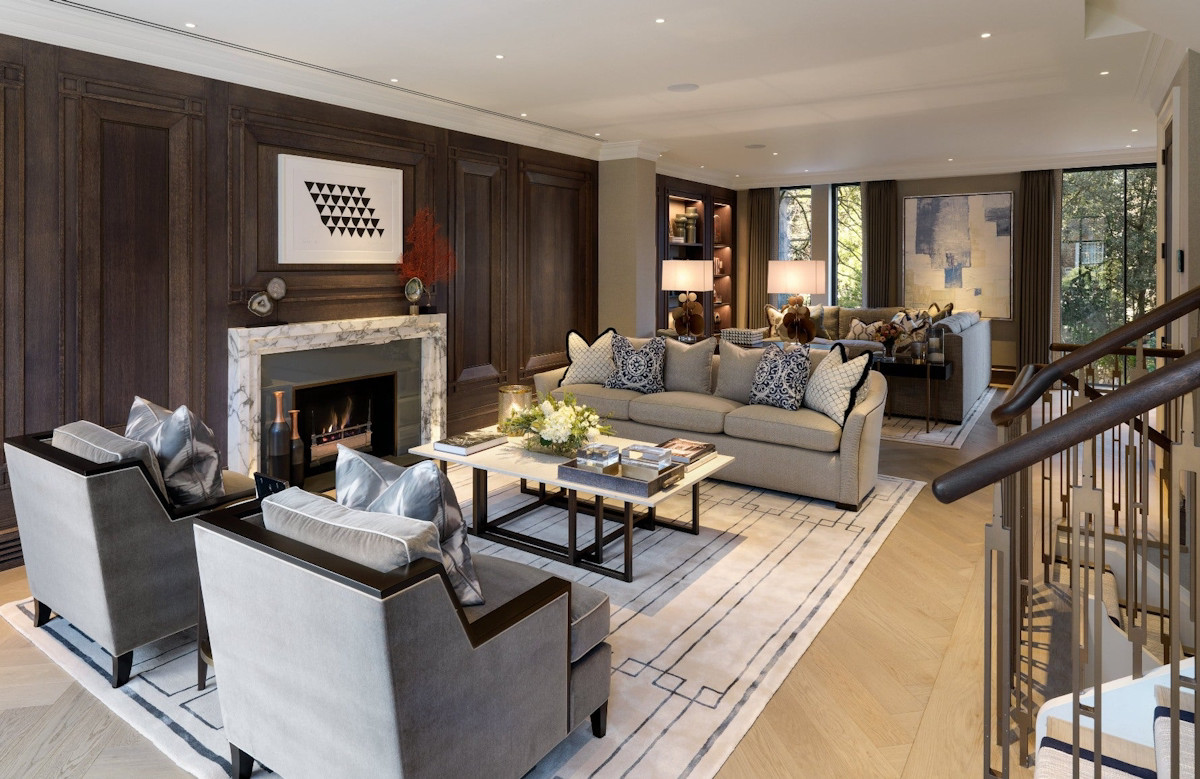
Think about the activities that are central to your lifestyle: Do you love curling up with a good book? A cozy reading nook could be perfect for one corner of the room. Need a space to work on creative hobbies? A craft or game area might make sense. Or perhaps you’d like to make the most of a view—consider placing a comfortable armchair or even a writing desk near a window to create a space where you can relax and soak up the scenery.
Lighting also plays a pivotal role in zoning. For example, a well-lit area near a large window could become a vibrant space for daytime tasks, while a darker corner might be ideal for a snug TV-watching zone with softer, ambient lighting. By considering the room’s natural layout, light sources, and your own needs, you can create meaningful sections that add structure and personality to your living room.
Create two Seating Areas
Large living rooms often call for more than one seating area, and for good reason. A single arrangement often struggles to fill the space, leaving large gaps that can feel awkward or underutilized. Instead, try creating two separate seating areas to make better use of the space and increase functionality.
Imagine a room that’s 30 feet long—filling that with just one oversized sofa and chairs would not only look unnatural but also make conversations feel strained due to the distance between seats. By incorporating two seating zones, you can add variety and practicality to your layout.
For instance, one area might be arranged around a coffee table for relaxed conversations or reading, while another could include a more casual setup with a sectional or armchairs facing a TV. This approach ensures that your room serves multiple purposes while preventing any area from feeling neglected or incomplete.
With these foundational layout strategies, you’ll create a large living room that feels balanced, inviting, and ready for anything.
Give Your Furniture Room to Breathe
One of the advantages of a large living room is the ability to space your furniture generously, creating an open and airy atmosphere. Unlike smaller spaces where items often feel cramped, a large room allows you to provide more breathing room between pieces, enhancing both the aesthetic and functionality of the space.
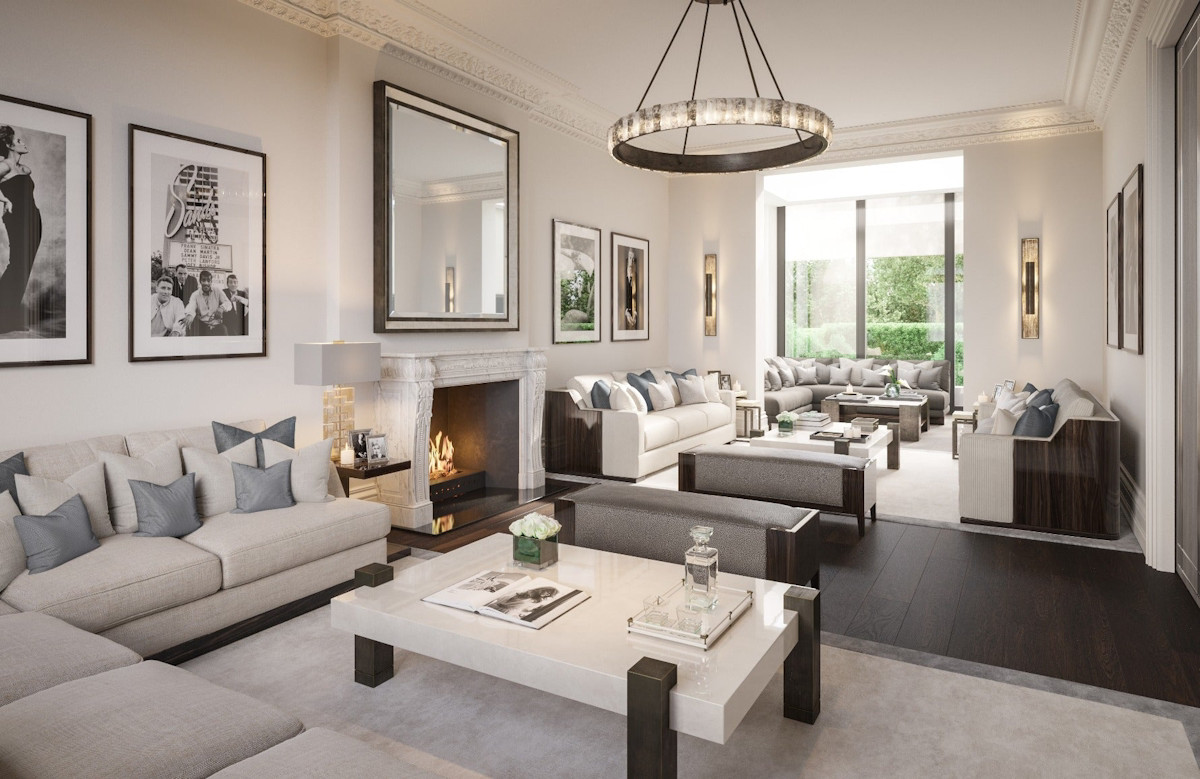
When arranging your furniture, aim for balance: seating should be close enough to foster natural conversation (generally no more than 10 feet apart) but spaced far enough to avoid a crowded look. Sofas and coffee tables, for example, don’t have to stick to the standard 18-inch distance if the room permits; feel free to push it out slightly to enhance comfort and accessibility.
Wide passageways between seating arrangements are another opportunity to make the room feel expansive yet connected. Incorporate elements like a central table or area rug to bridge gaps between separate furniture groupings while maintaining a sense of flow. By thoughtfully spacing your pieces, you’ll create an inviting, balanced design that embraces the room’s generous proportions.
Use Dividers to Define Spaces
Room dividers are a powerful tool in large living rooms, offering both form and function. By breaking up the space visually, dividers help to delineate different zones without sacrificing the openness of the room. There are several creative options to consider, depending on your needs and style preferences.
Movable pieces like elegant screens, freestanding bookcases, or even low-profile furniture such as a console table can add definition without permanence. These options are perfect if you want flexibility, allowing you to rearrange the room or open it up for larger gatherings as needed.
For a more grounded look, tall open bookcases can act as partial walls while still allowing light and interaction between zones. They’re ideal for creating separation between a formal seating area and a more casual nook.
If you’re seeking something more architectural, floor-to-ceiling built-in shelving units provide a striking and permanent way to break up a large space. Not only do they divide the room effectively, but they also add valuable storage and an opportunity to showcase decorative items, books, or plants.
Elevate Your Design with Split Levels
If you’re fortunate enough to be involved in the architectural design of your living room, a split-level layout can add both visual interest and practical separation to the space. By incorporating varying floor heights, you can create distinct zones that feel connected yet uniquely defined.
For example, a raised platform might house a formal seating area with elegant furniture and a statement rug, while a lower level could be designed as a more casual lounge or even a home theater space. This approach allows you to assign specific functions to each level, giving the room structure and purpose.
Split levels aren’t just functional—they’re also a fantastic way to make a large living room feel more dynamic and layered. Even subtle changes in elevation can introduce a sense of depth and intrigue, transforming the room from a flat, expansive area into a cohesive, multi-dimensional space.
Creative Solutions for Styling a Spacious Living Room
Decorating a large living room presents a unique opportunity to experiment with design ideas that might not work in smaller spaces. However, the abundance of space can also make the room feel intimidating or disjointed if not approached thoughtfully. By using clever design techniques, you can bring cohesion, warmth, and personality to the room while making the most of its generous proportions.
Let’s dives into innovative and practical styling tips to help you transform your large living room into a harmonious space that feels both inviting and functional. From experimenting with textures and colors to incorporating eye-catching focal points, these tricks will elevate your design and give every corner a purpose.
Using Color to Shape the Space
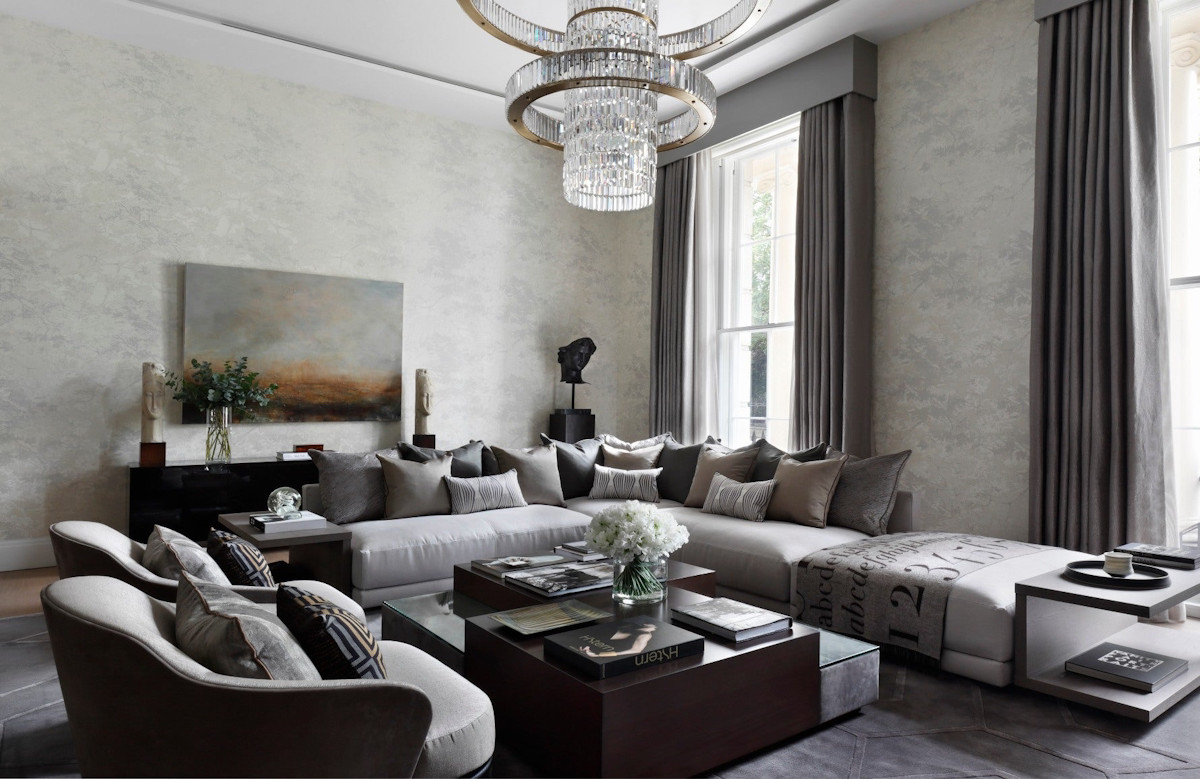
Color plays a transformative role in decorating a large living room, offering the ability to define areas and influence how the space is perceived. Darker or more saturated colors work particularly well in larger spaces, as they can add depth and warmth while subtly reducing the sense of vastness.
Deep shades like navy blue, matte black, or rich teal are excellent choices for walls, lending a sense of sophistication and coziness. These colors can be enhanced with luxurious textures such as grasscloth wallpaper, hand-painted finishes, or natural wood paneling, creating a tactile richness that complements the bold tones.
If you prefer a neutral color palette, focus on incorporating darker or more intense hues through furniture and accessories. A plush, dark-toned sofa, richly colored area rugs, or deep jewel-toned cushions can provide visual weight, anchoring the design without overwhelming the space. Similarly, the ceiling and flooring shouldn’t be overlooked. A darker ceiling can bring a sense of intimacy, while richly toned flooring can ground the room and provide a striking contrast to lighter walls.
By combining the principles of mass and strategic color choices, you can design a large living room that exudes charm and elegance. These techniques ensure that the space feels not only well-proportioned but also inviting, personal, and thoughtfully designed.
Enhancing Depth with Textures
Texture is a powerful yet often overlooked tool in transforming the look and feel of a large living room. Just as colors can shape how a space is perceived, textures add depth and dimension, creating a more dynamic and visually interesting environment.
Smooth, polished surfaces, such as glossy walls, sleek marble, or high-shine metallic finishes, give the impression of endless continuity. These seamless textures can make a large room feel even more expansive by reflecting light and emphasizing openness. However, if your goal is to make the space feel cozier and more grounded, textured materials are the way to go.
Incorporating textured wallpapers, such as grasscloth or embossed designs, adds subtle visual intrigue. Other options, like paneling, coffering, or custom ceiling finishes, can create implied depth while drawing the room’s proportions inward. For a truly unique touch, consider murals or hand-painted features that combine texture and artistry to create a striking focal point. By balancing smooth and textured elements, you can control how your living room feels—whether it’s airy and spacious or warm and intimate.
Leveraging Mass and Volume
The concept of mass in design relates to both the size of individual pieces and the visual impact of grouping objects together. In a large living room, both aspects are vital. Substantial furniture pieces, such as oversized sofas, large rugs, and tall bookshelves, fill the space proportionately and prevent it from looking empty or scattered. These larger items establish a sense of scale that suits the room’s dimensions, helping to anchor the design.
Massing, on the other hand, refers to the art of grouping smaller elements to create a cohesive visual impact. For instance, a cluster of pendant lights hung at different heights can become a striking centerpiece, while a carefully arranged gallery wall of art adds layers of texture and interest. A grouping of armchairs encircling a central coffee table can create a balanced and intimate seating area, lending purpose to an otherwise undefined section of the room. By thoughtfully balancing mass and volume, you can create an environment that feels both dynamic and proportionate.
Doubling Down on Coffee Tables
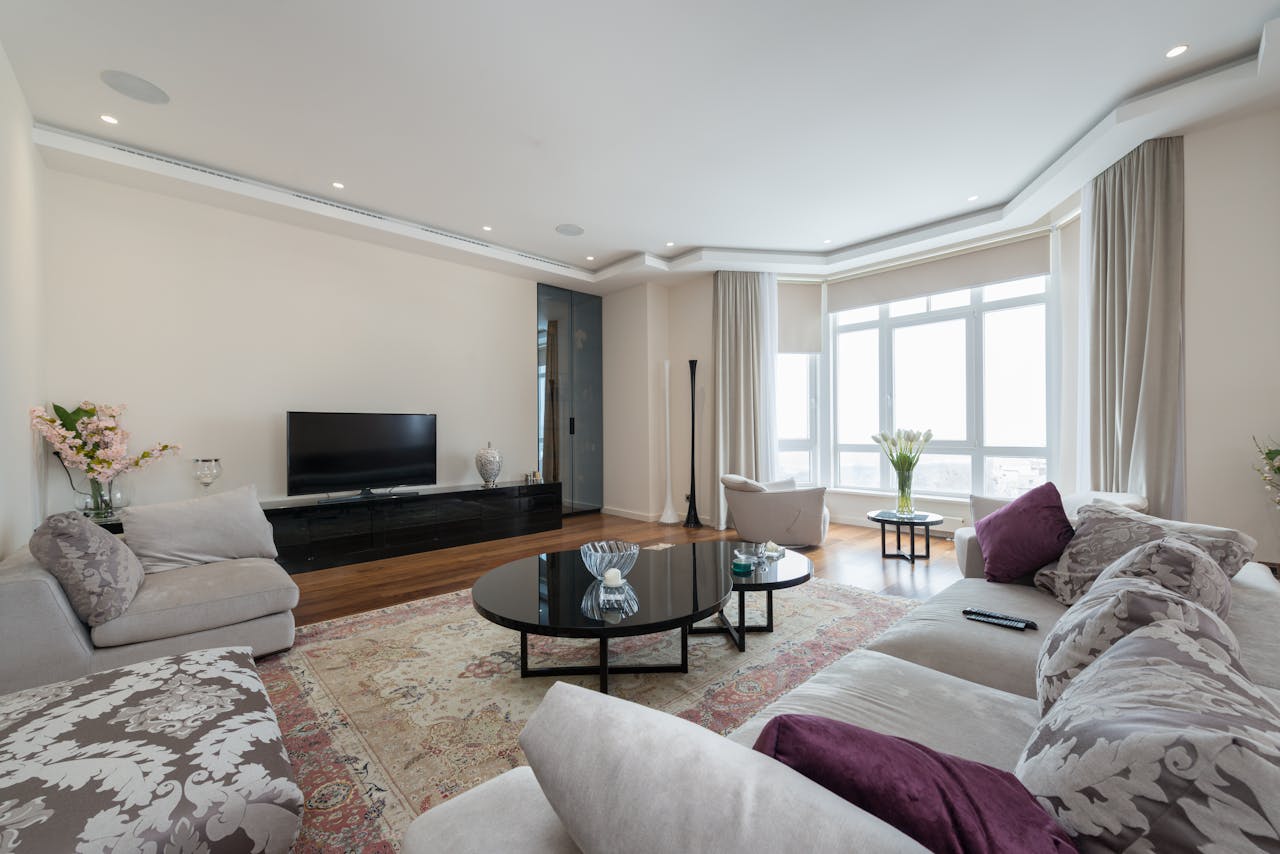
Large living rooms often call for inventive solutions, and one of the most stylish ways to address the scale of such a space is by incorporating double coffee tables. Rather than relying on a single oversized piece, a pair of coffee tables placed side by side creates a balanced anchor point for your seating area.
Matching designs work particularly well in symmetrical layouts, where the uniformity adds a sense of harmony. For a more eclectic look, consider nesting or interlocking tables that vary slightly in height or shape while complementing each other. This setup not only adds visual interest but also provides practical benefits, such as more surface area for books, decor, or entertaining essentials.
While the approach works beautifully with angular tables, some circular or organic shapes can also achieve the desired effect—provided the designs don’t overpower the space. A pair of understated wooden coffee tables suits a rustic setting, while lightweight metal options are perfect for modern aesthetics. The key is to select tables that enhance the overall design without overwhelming the arrangement.
Filling Spaces with Side Tables and Floor Lamps
Large living rooms often have pockets of unused space that can feel awkward if left empty. Extra side tables and floor lamps are an elegant solution, adding both functionality and a sense of completeness to your design.
Side tables are particularly effective when placed between armchairs or at the ends of a sofa. Even if they aren’t used daily, their presence enhances the ensemble and brings a sense of balance to the room. For a layered look, alternate between side tables and floor lamps. A tall, sculptural floor lamp can fill vertical space, while a sleek side table grounds the area and provides a surface for books, drinks, or decorative accents.
This interplay of height and function creates a varied yet cohesive look, ensuring every part of your living room feels intentional and thoughtfully designed.
Embracing Box-Shaped Furniture Arrangements
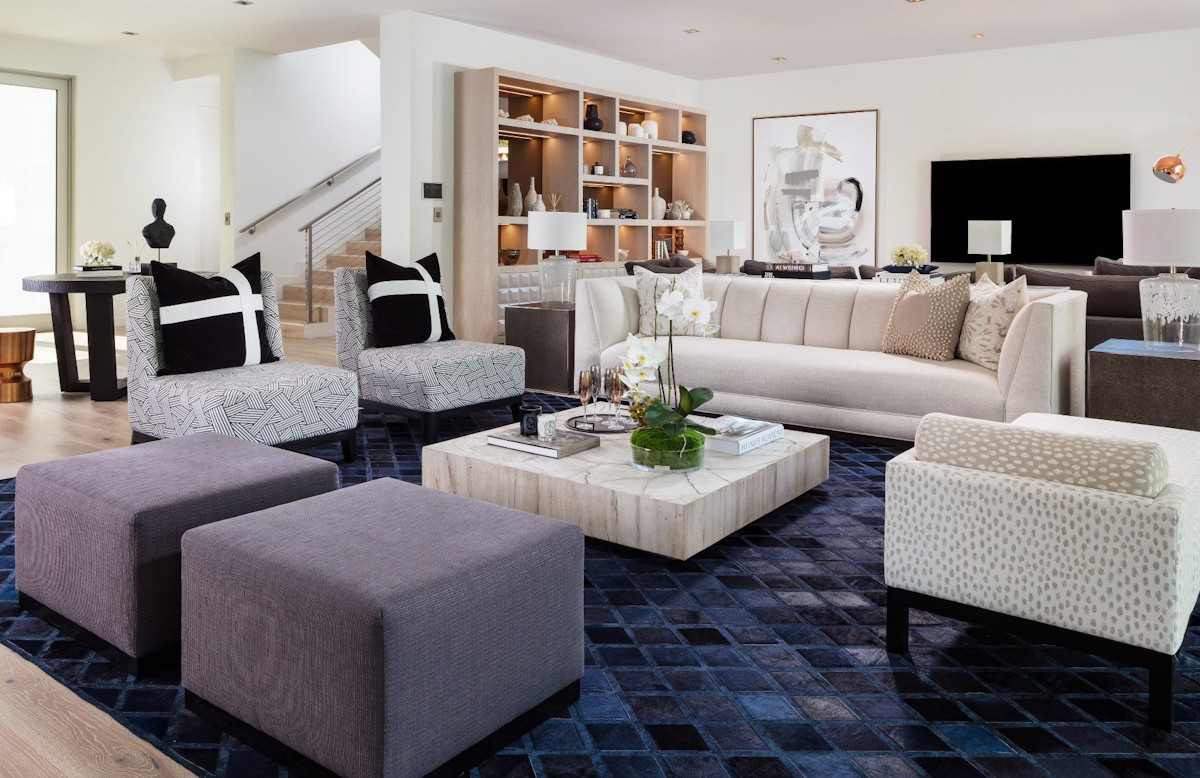
For those seeking a structured and elegant layout, a box-shaped furniture arrangement is an ideal choice for large living rooms. Unlike open or asymmetrical setups, this arrangement requires multiple furniture pieces placed in a rectangular or square configuration, with generous spacing between them.
Start with a central anchor, such as a coffee table or large ottoman, and build out from there with sofas, armchairs, and accent pieces. The symmetry of a box-shaped arrangement not only fills the space effectively but also fosters an inviting environment for conversation and socializing. This layout works particularly well for rooms with formal or classic design themes, as it emphasizes structure and balance.
Oversized Furniture: Bold Choices for a Bold Space
Large living rooms provide the perfect opportunity to incorporate oversized furniture and accessories, which might feel overpowering in smaller spaces. The right oversized pieces can enhance the room’s proportions and make a bold design statement.
An oversized sectional or custom-built sofa is an obvious starting point. A long, spacious sofa with a chaise lounge can anchor the room while offering ample seating. For uniquely shaped spaces, a custom sofa tailored to your needs ensures the perfect fit, whether it’s a wraparound design for a bay window or a striking L-shape that complements the room’s architecture.
Beyond seating, consider large-scale lighting fixtures, oversized artwork, or a dramatic area rug to define the space. These elements not only fill the room proportionately but also serve as focal points that draw the eye and add personality. By thinking big, you can create a living room that feels cohesive, luxurious, and uniquely your own.
Grounding the Room with Large Rugs
A rug is more than just a decorative accessory; it’s a foundational piece that brings cohesion and balance to a room. In a large living room, selecting the right rug is key to anchoring your furniture arrangements and creating distinct zones.
If your space accommodates multiple seating arrangements, use separate rugs for each to visually define the areas. A rug that is large enough to encompass all the furniture within a zone—sofas, chairs, and tables—creates a grounded and unified look. For an even bolder statement, choose a single oversized rug that stretches beneath all the furniture arrangements, giving the room a luxurious and expansive feel.
Texture and color also play an important role in rug selection. Vibrant tones like emerald green or cobalt blue can make a striking impact and fill the space visually, while neutral or textured designs can add subtle depth and warmth. Whether you opt for a bold or understated design, a well-chosen rug will serve as the backbone of your large living room layout.
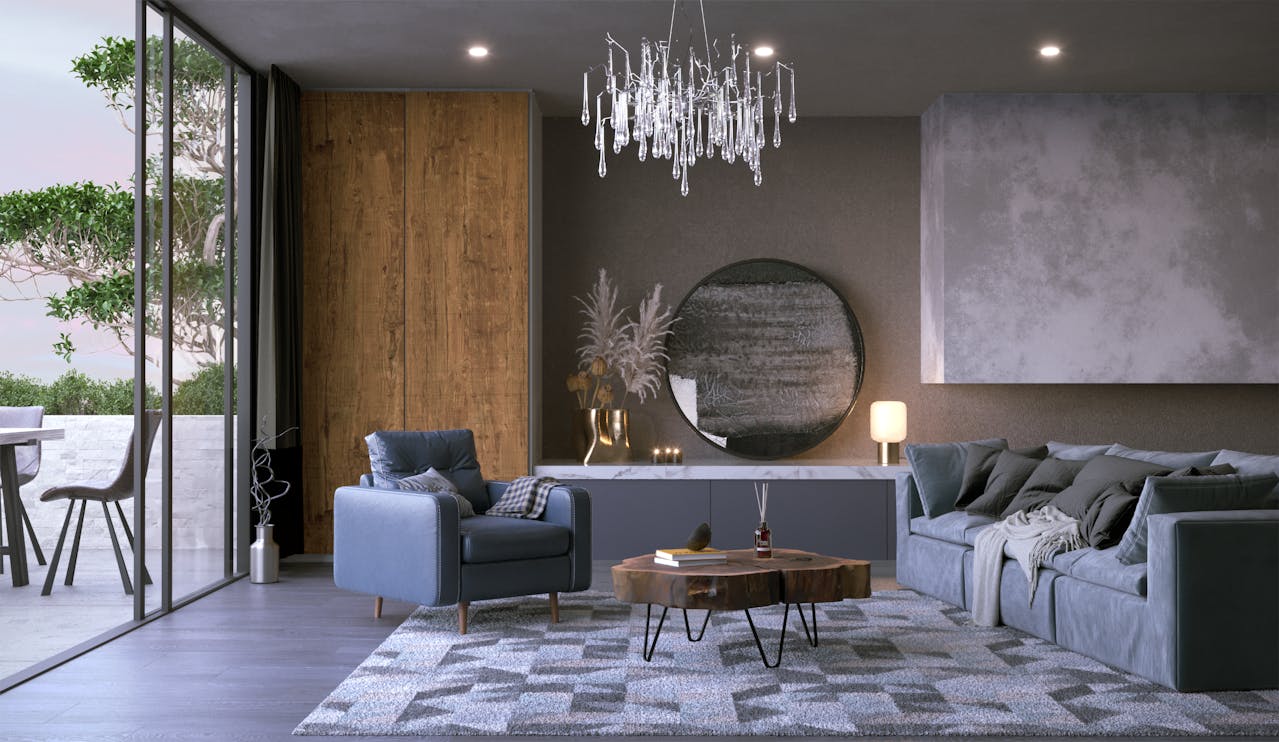
Elevating the Space with Oversized Wall Art
Large living rooms often come with vast wall spaces that can feel empty or stark if left unadorned. Oversized wall art is an elegant solution that fills these spaces while adding personality and focus to your design.
A grand painting, print, or photograph can act as a statement piece, drawing attention to key areas like a sofa wall, fireplace, or open expanse. To truly match the scale of the room, consider commissioning or sourcing custom art that spans the full height or width of the wall. This approach creates a bespoke and intentional look, transforming your living room into a gallery-like space.
If you prefer a curated vibe, combine large-scale art with smaller pieces for a layered effect. The goal is to find balance—art that feels proportionate to the size of your room without overwhelming it.
Reflecting Style with Large Mirrors
Large mirrors are another fantastic tool for decorating a spacious living room. Not only do they reflect light to brighten the space, but they also create an illusion of depth and intrigue. When positioned thoughtfully, a large mirror can highlight interesting features of your room, such as a statement wall, unique architecture, or a textured finish.
However, mirrors in large spaces require careful placement. Avoid positioning them in a way that unintentionally emphasizes the room’s size, such as opposite a window or open archway, as this can make the space feel even bigger and potentially colder. Instead, use mirrors to add balance and focus, ensuring they complement rather than overpower the design.
Opting for a Grand Coffee Table
A large living room calls for a coffee table that matches its scale. A generously sized coffee table serves as a central anchor point, providing functionality while visually filling the space. Opt for a design that allows for both decorative displays and practical use, such as holding books, floral arrangements, or personal accessories.
To enhance the table’s impact, lean into massing techniques by clustering decor items together. A mix of textures, heights, and shapes will make the table visually appealing while keeping it cohesive. Whether you choose a bold sculptural piece or a more minimalist design, a large coffee table ensures the seating area feels complete and proportional.
Making a Statement with a Large Chandelier
Lighting is a crucial element in any living room, but in a large space, it’s an opportunity to create a show-stopping centerpiece. A chandelier, when scaled appropriately, can bring grandeur and cohesion to your design.
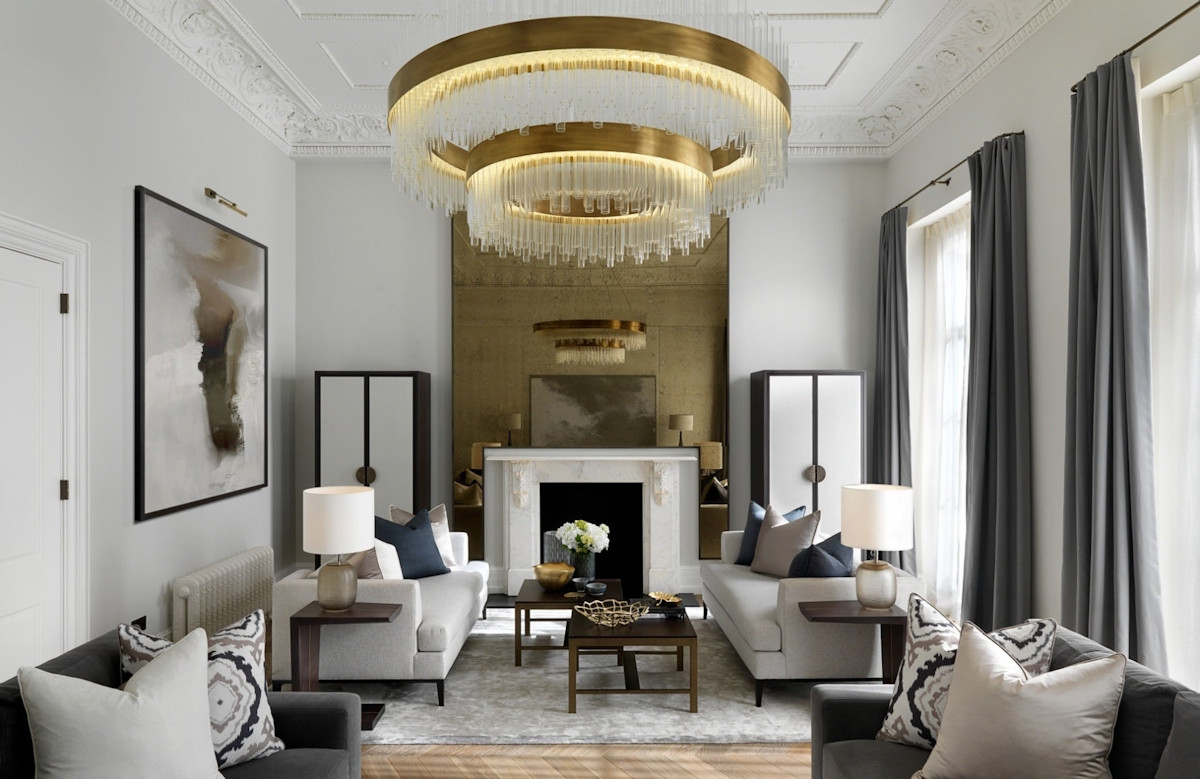
The general rule of thumb for sizing a chandelier is to add the room’s length and width (in feet) and convert the sum into inches for the fixture’s diameter. For instance, a room measuring 20 by 25 feet would benefit from a chandelier roughly 45 inches in diameter. Similarly, the chandelier’s height should be 2.5 to 3 inches for every foot of ceiling height, ensuring it feels balanced within the vertical space.
From modern geometric designs to classic crystal styles, a well-chosen chandelier will illuminate your living room while adding a touch of elegance and sophistication.
Key Strategies for Perfecting a Large Living Room
Designing a large living room requires attention to details that might not be as critical in smaller spaces. Sound, lighting, and visual balance play an even greater role in ensuring the room feels complete and inviting. These final considerations will help you address the unique challenges that come with a spacious living area, creating a harmonious and comfortable environment.
Minimizing Echoes with Thoughtful Design
Large rooms, with their vast surfaces and open layouts, often suffer from echoing, which can make the space feel cold and impersonal. To combat this, focus on incorporating soft furnishings and textiles that absorb sound and add warmth.
Layered rugs, plush carpets, and heavy drapes over windows are excellent solutions for reducing echoes while adding texture and comfort to the room. Upholstered furniture, such as armchairs and sofas, also helps to dampen sound. For a more artistic approach, consider hanging tapestries, using fabric wall coverings, or opting for acoustic panels disguised as artwork. These elements not only improve the room’s acoustics but also enhance its visual appeal, making the space feel cozier and more intimate.
Lighting That Works for the Scale
Lighting is a cornerstone of successful interior design, and in a large living room, it’s essential to think beyond basic fixtures. The size of the room demands layered lighting that serves multiple functions, from general illumination to accent and task lighting.
While a central chandelier or statement pendant light can serve as a stunning centerpiece, it won’t be enough to light the entire space effectively. Supplement it with recessed spotlights, track lighting, or wall sconces to brighten darker corners and ensure even distribution of light. Floor lamps and table lamps are also indispensable for creating a warm, inviting atmosphere.
For an elegant approach, consider architectural lighting, such as integrated joinery lights that highlight shelves or cabinetry. Aim for around 20 lumens per square foot to achieve sufficient brightness, and work with a designer or contractor to create a lighting plan that complements the room’s layout and style.
Defining the Space with a Focal Point
A large living room often benefits from a strong focal point to draw the eye and bring a sense of purpose to the design. Without one, the sheer size of the space can feel overwhelming or underwhelming, depending on how it’s styled.
If your room has an inherent focal point, such as a fireplace or large window with a view, build your layout around it to emphasize its presence. For rooms without a natural feature, create one with intentional design choices. A statement wall adorned with bold wallpaper or paneling can instantly capture attention, as can an oversized mirror or a large piece of artwork. Unique furniture pieces, such as a dramatic coffee table or a custom-built shelving unit, can also serve as striking focal points that tie the room together.
By addressing these special considerations—acoustics, lighting, and focal points—you can refine your large living room’s design and elevate it to its full potential. Whether you’re starting with a blank slate or reimagining an existing space, these strategies ensure your living room feels balanced, inviting, and truly exceptional.